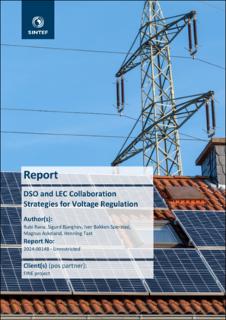DSO and LEC Collaboration Strategies for Voltage Regulation
Research report
Published version
Permanent lenke
https://hdl.handle.net/11250/3126540Utgivelsesdato
2024Metadata
Vis full innførselSamlinger
- Publikasjoner fra CRIStin - SINTEF Energi [1649]
- Rapporter fra SINTEF Energi [277]
- SINTEF Energi [1773]
Sammendrag
This report explores the long-term perspective of Local Energy Community (LEC) integration, considering future grid challenges like load increases leading to voltage problems. It examines the role of LECs in reducing peak loads and subsequent contribution to voltage regulation, especially when LECs include flexible resources. The report focuses on three key scenarios: Business as Usual, Local Coordination, and Efficient Market, each illustrating different interactions and integration levels between LECs, LEC operators, and Distribution System Operators (DSOs). The study highlights the economic and operational trade-offs between different scenarios, with a focus on the balance between DSO-LEC costs and benefits. The study also highlights the importance of the location of LECs in the grid for voltage regulation and incentive allocation based on LECs contribution to solving voltage issues. Our findings show that LECs effectively reduce undervoltages, especially in winter. While their impact on overvoltages is currently limited due to seasonal mismatches between PV generation and load, increasing future loads may enhance their role in mitigating summer overvoltages. DSO and LEC Collaboration Strategies for Voltage Regulation

